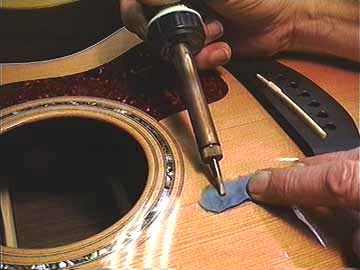Page 1 of 2
Sometimes it really works!
Steaming Out Dents
© Frank Ford, 3/28/98; Photos by FF, 3/26/98
"Can you take this dent out?" asks the guitar's owner.
My usual response is to explain that we're talking about a hole or place where there's
something missing, and that we'll have to consider filling in the dent. But sometimes
it actually is possible to remove a dent.
If I work patiently and take enough time, I can sometimes coax the wood underneath
the finish to swell back to its original thickness, provided that not too many wood
fibers are crushed.
Here's a perfect example of a job that went just right.
The instrument in question is a Taylor guitar, model 714, with a cedar top. Cedar
is the most easily damaged of the conventional guitar top woods, and this one took
a nasty blow from a not-so-blunt object.
This dent was a deep one:

It was in the soft grain between two hard grain lines, with no apparent break or
crack in the finish.
It's really hard to photograph this up close, without too much glare. That's why
the color is so different in the long shot.
I heated up my soldering iron, and began to "steam" the dent. I laid a
small piece of water soaked paper towel over the spot, and gently pressed the tip
of the hot iron directly over the dent. Immediately, I'd move the wet paper towel
aside and look at the results. I'm VERY concerned and careful not to overheat and
melt the finish!

I continued wetting the paper towel, touching it with the iron to release water vapor
(steam) and moving it aside to allow the finish to cool as it seemed necessary. I
spent about a ten minutes with this process before I noticed any change at all.
After about a half hour, and well over a hundred little applications of the soldering
iron, the dent finally became raised almost flush with the surrounding surface:

Here it isn't perfectly smooth and level, but it is raised considerably. You may
also notice that the area nearby shows a little "washboard" effect as the
added moisture caused the soft grain to swell.
I was tempted to sand the surface level and polish it right away, but I waited because
I knew that later the extra moisture would dissipate, and the area would shrink back
just a teeny bit. If I had rubbed out right away, I'd have been left with a depression
in the area when it dried thoroughly.
The next day, I sanded with a cork block and 2500 grit waterproof paper using kerosene
as a lubricant. Then I buffed the area, and it came out like this:

If you look REALLY closely, you can see just a little deformation of the wood fibers
under the finish. The finish shows no sign of a dent in reflected light.
I can't overstate the need to be careful of the heat and moisture. Lots of old finishes
will blush and turn white, blister or melt if they're overheated! This instrument
has the most cooperative finish - a catalyzed polymer that will stand the heat of
steaming.
Things don't always work out this neatly, but it is usually productive to apply a
little steam to a dent to allow the wood fibers to regain their most relaxed position.
Then, a subsequent fill won't have to be as deep.
I've never been able to predict the exact results. Sometimes it seems a shallow dent
just won't swell up they way I expect. Here, a deep one went better than I predicted.
As my friend, Brian Burns, always says, "If you're lucky enough you don't need
skill!" I can go with that.
Here's a more typical job. This ding is very deep. I was able to drop the depth gauge
of my dial caliper into the dent and it read 0.011" deep. It actually looks
even deeper than that, doesn't it?

The finish is cracked at the edges of the wound, so steam could penetrate under the
finish faster than the Taylor job on page one. I steamed for about ten minutes before
I was certain that I could get no more swelling of the wood. This is a Martin guitar
with nitrocellulose lacquer finish which is much more sensitive to the heat and moisture.
As you can see, after ten minutes of careful work, I have raised the dent considerably,
but I've also affected the surface of the finish:

The surface effect of my heat was not very deep, so the next day I was able to sand
the finish level with a cork block and 1000 grit waterproof paper, lubricated with
kerosene
After a quick buffing, you can see that the dent is only a fraction of its former
self:

From here, I'll fill the dent with new lacquer and blend it to the surrounding surface.
The advantage of steaming is that I need to build up far less depth of lacquer to
fill the dent, so my final result will be a less noticeable repair.
More
1
2
Back to Index Page
